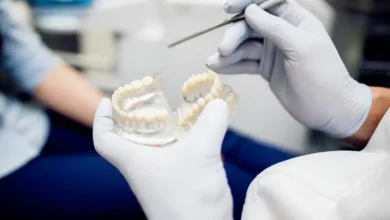
Discolored Teeth: Top Reasons Your Smile May Be Losing Its Sparkle
A bright, white smile is often seen as a sign of health and vitality, but many people struggle with discolored teeth that can affect their confidence. Tooth discoloration is a common issue, and it can happen for several reasons, some of which may be preventable. Whether it’s caused by lifestyle habits, dietary choices, or natural aging, understanding the root causes of discolored teeth can help you take the right steps to restore your smile. Let’s explore the most common reasons why your teeth might be losing their sparkle.
1. Poor Oral Hygiene Habits
The most basic cause of tooth discoloration is poor oral hygiene. When you don’t brush and floss regularly, plaque and tartar accumulate on your teeth. Plaque is a sticky film of bacteria that, if not removed, can harden into tartar, which can cause yellowing and staining. Moreover, without proper cleaning, food particles and beverages like coffee or wine are left on the teeth, contributing to staining over time. Brushing your teeth at least twice a day and flossing regularly can prevent plaque buildup and maintain the brightness of your smile.
2. Dietary Choices
Certain foods and drinks are notorious for causing tooth discoloration. These include:
- Coffee and Tea: Both beverages contain tannins, which can stain your teeth by attaching to the enamel. Over time, frequent consumption can lead to stubborn stains.
- Red Wine: Like coffee, red wine has tannins and pigments that can leave behind discoloration.
- Berries: While nutritious, berries like blueberries, blackberries, and raspberries contain pigments that can stain teeth.
- Curry and Soy Sauce: These foods contain strong-colored compounds that can cause discoloration, especially when consumed frequently.
- Soda: Dark sodas can stain teeth due to their acidic nature and the artificial colorants they often contain.
If you love these foods and drinks, it’s important to rinse your mouth with water after consumption or brush your teeth afterward to reduce the risk of staining.
3. Smoking and Tobacco Use
Smoking or using other tobacco products is one of the leading causes of discolored teeth. Nicotine and tar can seep into the porous enamel of your teeth, leaving behind stubborn yellow or brown stains. Tobacco stains are difficult to remove and tend to deepen over time. In addition to staining teeth, smoking can lead to other oral health problems, including gum disease and bad breath. Quitting smoking is not only beneficial for your oral health but for your overall well-being as well.
4. Aging
As we age, the outer layer of enamel on our teeth naturally wears down, revealing the dentin beneath. Dentin is a yellowish substance that can cause teeth to appear darker as the enamel thins. The natural aging process can also cause enamel to become more porous, making it easier for stains to set in. While aging is inevitable, you can help slow down enamel erosion by avoiding acidic foods, maintaining good oral hygiene, and using toothpaste designed to protect enamel.
5. Medications
Certain medications can cause tooth discoloration as a side effect. For instance, some antibiotics, particularly tetracycline, can lead to a yellow, brown, or gray discoloration of developing teeth in children. Antihistamines, high blood pressure medications, and chemotherapy drugs can also cause discoloration in adult teeth. If you are on any of these medications and notice changes in your smile, it’s a good idea to talk to your dentist. They may be able to suggest alternatives or recommend whitening treatments to help restore the appearance of your teeth.
6. Fluorosis
Fluorosis is a condition that occurs when there is an excessive amount of fluoride during the early years of tooth development. It can cause white or brown spots on the teeth, making them look discolored. Fluorosis typically affects children who drink too much fluoridated water or swallow toothpaste containing fluoride. While the condition is preventable by supervising children’s use of fluoride toothpaste, it can be difficult to treat once the teeth are fully developed.
7. Genetics
Believe it or not, genetics can also play a role in the natural color of your teeth. Some people simply have thinner enamel or more porous enamel, which can make their teeth appear more yellow. Others may inherit naturally whiter teeth. While genetics can’t be changed, good oral hygiene habits and professional whitening treatments can help brighten your smile if you find your natural color lacking.
8. Trauma or Injury
A blow to the mouth or teeth can occasionally lead to discoloration. When a tooth sustains an injury, it may darken due to internal bleeding or damage to the pulp (the inner tissue) of the tooth. In such cases, more advanced treatments, such as root canal therapy or the placement of a dental crown, may be necessary to restore the tooth’s natural appearance. If you’re dealing with tooth discoloration from an injury, cosmetic dentistry in Las Vegas offers a range of solutions to help you regain a bright, healthy smile.
9. Dental Fillings and Restorations
While dental fillings and restorations like crowns and veneers are designed to improve the function and appearance of your teeth, they can sometimes become discolored over time. Certain materials, such as silver or amalgam fillings, may cause a grayish tint to nearby teeth. In these cases, it may be necessary to replace old fillings or crowns to restore the natural color of your teeth.
In Conclusion
There are many reasons why teeth can become discolored, ranging from lifestyle choices to natural aging. The good news is that many of these causes can be prevented or managed with proper dental care, lifestyle changes, and professional treatments. If you’re concerned about tooth discoloration, the first step is to consult with your dentist. They can help identify the cause of your discoloration and recommend the best course of action for restoring your bright, white smile. Whether it’s a simple cleaning, teeth whitening, or other treatment options, taking care of your teeth is an investment in both your oral health and your confidence.



